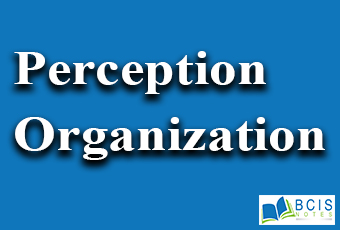
Perceptual Organisation:
We perceive objects of our environment as having a different pattern, depth, constancy, and movement. The perceptual organization integrates sensation into percepts(meaningful perceptual units, such as images of particular objects), locates them in space, and preserves the meaning. Four major features of Perceptual Organisation are listed below:
- Form Perception
- Depth and Distance Perception
- Motion Perception
- Perceptual Constancy.
1. Form Perception:
It refers to the organization of sensations into meaningful shapes and patterns(Weston, 2002). Example; when you’re holding a book, you do not perceive it as a patternless collection of molecules; you perceive it as a whole. This phenomenon is called a ‘Gestaltist’. Gestalt psychologist proposed that human are born with an ability to organize the elements of our perceptual world by producing the best or most complete perception of the environment. Form Perception includes figure and ground and laws of grouping.
Figure and Ground perception:
When we see a visual stimulus, the center of our attention that attracts our vision is called the figure and the rest is indistinct background called the ground. Example; the picture hanging on the wall, words on a page, mountains against the sky, are perceived as figure while the wall, page, and sky are the ground.
Characteristics of Figure and Ground perception:
- The figure is the focus of our attention; the ground constitutes the remainder of our perception.
- The figure is perceived as near to the person and ground far from the person.
Laws of Grouping perception:
In Perceptual Organisation, Gestaltist psychologists demonstrated that we organize our perception by grouping elements. Our mind follows bring order and form to these basic sensations. Example; the letters in this book when falling into groups we call words, what would it be if one had to think about every single letter. Laws of Grouping are as follows:
- Similarity
- Proximity
- Continuity
- Closure
Similarity:
The brain tends to group similar objects together. According to the Gestalt principle of similarity, items that are alike are grouped together. Example; XXX000’s are perceived as three’X’s and three ‘0’s. Similarly, people perceive the same circle or triangles in horizontal rows of similar shapes.
Proximity:
The brain tends to group together objects that are close to one another. Items that are close to one another are perceived as a group. Example; We see not separate lines but three sets of two lines. The team is more powerful than proximity.
Continuity:
If possible the brain organizes stimuli into continuos lines or patterns rather than discontinuous elements. We perceive continuous flowing lines more than broken lines.
Closure:
People tend to perceive incomplete figures as complete. If part of a familiar shape is missing, perceptual, process complete the pattern, to create a complete whole object. Example; political parties put forward their agenda or strategies despite different disputes within themselves.
2.Depth and Distance Perception:
The second aspect is Depth and Distance Perception. Psychologists have puzzled by the question of how we are able to perceive depth or distance. The surface of the retina is 2D. It has no depth. Eye and brain accomplish this by using two main types of cues:
- Binocular cues
- Monocular cues
Binocular cues:
It requires visible input integrated from the two eyes. Convergence and Retinal disparity are two binocular cues.
Convergence: Our eye muscles contract to move the eyeballs to see things clearly. We focus on nearby objects properly.
Retinal disparity: It is the difference between the two views. Because our eyes are about 2.5 inches apart our retina receives slightly different pictures of the same object or situation. Vision is clear if involve both eyes.
Monocular cues:
They are seen by one eye alone. There are different monocular cues to help depth or distance:
- Interposition
- Linear perspective
- Aerial Perspective
- Linear Perspective
- Retinal Image
- Texture Gradient and so on.
You may also like Introduction to Illusions and Delusion

Leave a Reply